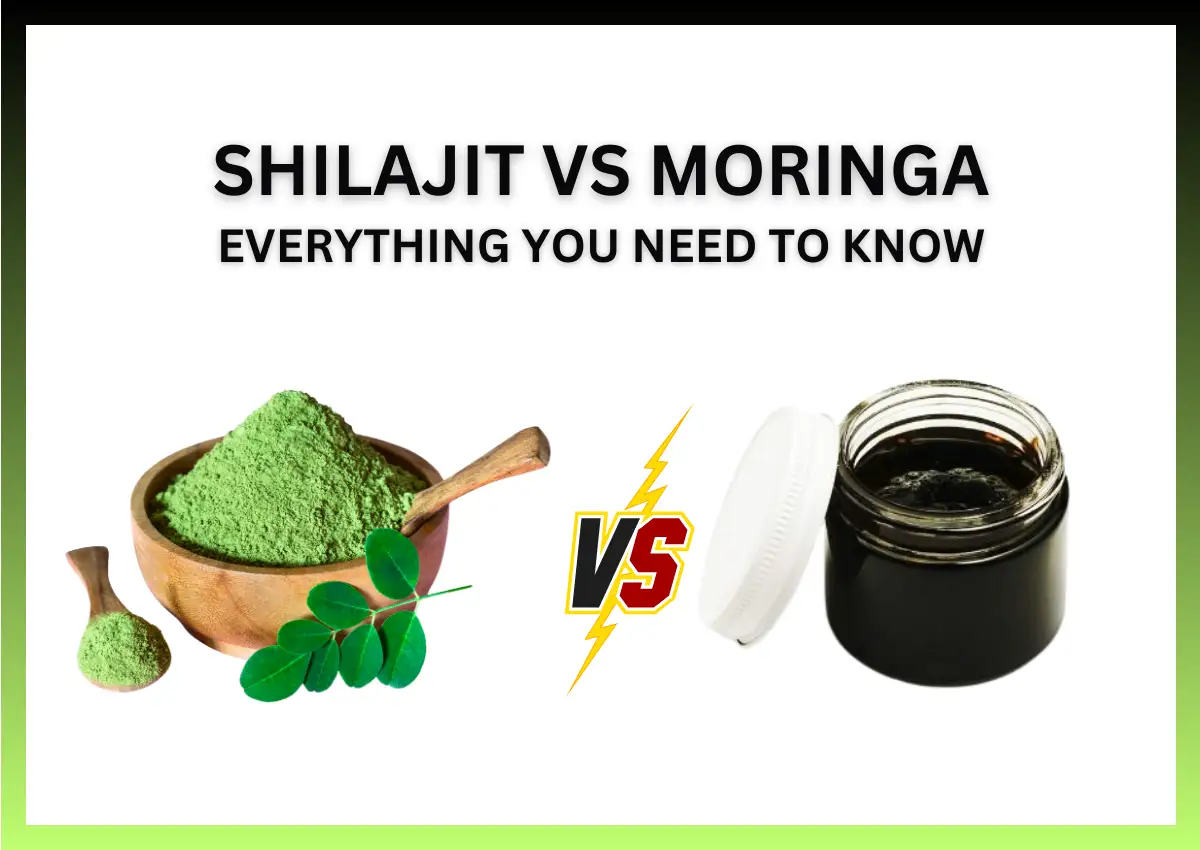When it comes to natural wellness, few herbs and medicines have gained as much attention as Shilajit and Moringa.
Did You Know?
It can increase ATP production, giving your cells more energy naturally.
In this Shilajit vs Moringa guide, we’ll explore what makes each of them unique, their health benefits, and how they compare in terms of nutrition and traditional uses.
Image Credit: Created with AI only for education
Both have been valued for centuries in different cultures—Shilajit in the Himalayan regions and Moringa in tropical and subtropical areas—yet they work in very different ways to support the overall wellness of human health. By the end, you’ll know which one might best fit your health goals.
What is Shilajit?
Shilajit is a sticky and tar-like mineral resin that comes from the rock layers of the Himalayan mountains during the warmer months.
Formed over centuries through the slow decomposition of nearby plants and minerals under high pressure, it carries a unique nutritional and chemical profile unlike any other natural supplement.
Image Credit: Created with AI only for education
Rich in fulvic acid, humic acid, dibenzo-alpha-pyrones, and over 80 trace minerals, Shilajit has been prized in Ayurveda for thousands of years. It is classified as a Rasayana—a rejuvenator that supports energy, vitality, longevity, and overall balance in the body.
Modern research has started to confirm some of its traditional claims. Studies suggest Shilajit may enhance ATP production for better energy, support cognitive performance, and aid in physical recovery.
Its combination of bioactive compounds and mineral content makes it a potent adaptogen for overall health.
Dosage of Shilajit
The ideal dosage of Shilajit depends on its form and purity. For high-quality purified resin, most adults take around 300–500 mg daily, while capsules or powder usually range from 250–500 mg per day as per manufacturer guidelines.
How to Use Shilajit
Shilajit resin is traditionally dissolved in lukewarm water or milk before drinking, while resin, capsule or powder forms can be taken with meals for better absorption.
Ayurveda often recommends combining it with warm milk or ghee to enhance its rejuvenating effects. Avoid pairing Shilajit with alcohol or heavily processed foods, as these may diminish its benefits.
Side Effects of Shilajit
Pure, lab-tested shilajit is generally safe for most healthy adults, but side effects can occur if it is unpurified or taken in excess. Possible reactions include mild digestive discomfort, dizziness, or increased heart rate in sensitive individuals.
Precautions for Shilajit
Shilajit should be avoided by pregnant or breastfeeding women, individuals with hemochromatosis, or those with active infections. People with chronic illnesses or those on prescription medications should consult a healthcare professional before starting. Always choose certified, purified Shilajit to avoid heavy metal contamination.
What is Moringa?
Moringa, often called the “drumstick tree” or “miracle tree,” is a fast-growing plant native to parts of South Asia and Africa.
Image Credit: Created with AI only for education
Nearly every part of the tree — leaves, pods, seeds, and flowers — is edible and used for medicinal or nutritional purposes by man.
Moringa leaves are rich in vitamins A, C, and E, along with calcium, potassium, iron, and high-quality plant protein.
They also contain bioactive compounds like quercetin, chlorogenic acid, and beta-sitosterol, which contribute to their antioxidant, anti-inflammatory, and blood sugar–balancing effects.
In the traditional medicine systems, Moringa has been valued for supporting digestion, immunity, lactation in new mothers, and general vitality.
Modern research supports many of these uses, showing potential benefits in reducing oxidative stress, improving nutrient status, and supporting cardiovascular health.
Its nutrient density and versatility make Moringa both a food and a functional superfood for overall wellness.
Recommended Dosage of Moringa
Moringa leaf powder is typically consumed in doses of 1–3 teaspoons ( which means 2–6 grams) daily. In capsule form, the standard dosage ranges from 500–1,000 mg per day, depending on the concentration and intended purpose.
Fresh leaves or cooked pods can be eaten freely as part of a balanced diet.
How to Take Moringa
Moringa powder can be mixed into smoothies, soups, juices, or sprinkled over salads. Fresh leaves can be cooked like spinach, while the long pods are commonly added to curries.
Image Credit: Created with AI only for education
For supplementation, capsules or tablets offer a convenient option for those who don’t enjoy its earthy taste. Avoid heating the powder at very high temperatures to preserve its nutrients.
What are the Possible Side Effects of Moringa
Moringa is generally well-tolerated when consumed in food amounts. However, excessive intake of leaf powder may cause mild digestive issues like nausea or diarrhea.
Moringa seeds and roots contain compounds that can be toxic in large quantities and should be consumed with caution.
Precautions for Moringa
Pregnant women should avoid Moringa root, bark, and flowers, as they may have uterine-stimulating properties.
People taking blood-thinning, blood pressure, or blood sugar–lowering medications should consult a healthcare provider before use, as Moringa may enhance these effects. Always source Moringa from reputable suppliers to avoid contamination with heavy metals or pesticides.
Nutritional Composition And Side-by-Side Comparison
While both Shilajit and Moringa are considered nutrient powerhouses, their nutritional makeup is very different.
Shilajit is a mineral-rich resin with unique and high bioactive compounds, whereas Moringa is a whole plant food loaded with vitamins, minerals, and plant proteins.
The table below highlights their key differences:
| Nutritional Aspect | Shilajit | Moringa |
| Major Compounds | Fulvic acid, humic acid, dibenzo-alpha-pyrones | Vitamins A, C, E, K; calcium, potassium, iron |
| Antioxidant Capacity | High due to fulvic acid and phenolic compounds | High due to vitamin C, quercetin, chlorogenic acid |
| Protein / Amino Acid Profile | Contains small peptides and amino acids, but not a major protein source | Contains all 9 essential amino acids in its leaf protein |
| Trace Minerals | Over 80 trace minerals including zinc, magnesium, copper, selenium | Contains iron, magnesium, calcium, and potassium |
| Bioavailability Factors | Fulvic acid enhances mineral absorption at the cellular level | Natural fiber and antioxidants aid nutrient stability and absorption |
Health Benefits of Shilajit vs Moringa
Energy & Vitality
Shilajit: Supports the body’s natural energy systems by boosting ATP production and improving mitochondrial efficiency, which helps reduce fatigue and enhance stamina.
Moringa: Provides sustained, steady energy through its balanced nutrient density, offering iron, B vitamins, and antioxidants that combat tiredness without causing energy crashes.
Cognitive Health
Shilajit: Exhibits neuroprotective effects by reducing brain cell damage, improving memory retention, and promoting mental clarity through antioxidant and adaptogenic compounds.
Moringa: Protects brain health via antioxidant protection from compounds like quercetin and chlorogenic acid, and may support mood regulation and mental focus.
Anti-Inflammatory Effects
Shilajit: Reduces oxidative stress and modulates inflammatory pathways, making it beneficial for joint health and recovery from physical strain.
Moringa: Contains quercetin and isothiocyanates, which provide strong anti-inflammatory action, potentially easing symptoms of arthritis, asthma, and metabolic disorders.
Longevity & Anti-Aging
Shilajit: Promotes cellular regeneration, protects telomeres, and supports healthy aging through improved nutrient delivery at the cellular level.
Moringa: Prevents oxidative damage to cells, helping maintain skin elasticity, organ function, and overall vitality over time.
Weight Management
Shilajit: Supports metabolism and energy utilization by boosting ATP production, which helps the body burn fat more efficiently while reducing fatigue during your workouts.
Moringa: Helps with weight loss through appetite control, high fiber content, and compounds that reduce fat formation, while delivering essential nutrients to support overall health.
Heart Health
Shilajit: Improves circulation and supports endothelial function, aiding in overall cardiovascular efficiency.
Moringa: Helps regulate blood pressure and supports cholesterol balance, reducing risk factors for heart disease.
Blood Sugar Management
Shilajit: May aid glucose metabolism by improving insulin sensitivity and reducing oxidative stress linked to metabolic imbalance.
Moringa: Has shown effectiveness in lowering and stabilizing blood sugar levels due to its polyphenols and chlorogenic acid, making it beneficial for those managing prediabetes or type 2 diabetes.
Now, let’s talk about a Reddit thread where people discuss the benefits of Shilajit and Moringa. Below is a summary for reference:
Image Credit: Reddit image used only for education
Who Should Take Shilajit vs Moringa?
While both Shilajit and Moringa can support overall your body health, choosing between them often comes down to your specific goals and needs.
Shilajit is the best for athletes and active individuals
Shilajit’s ability to enhance ATP production, helps to improve mitochondrial efficiency, and speed up recovery makes it well-suited for those with high physical demands, such as athletes, gymers, and outdoor adventurers.
Moringa is the best for general wellness and nutrient
With its broad spectrum of vitamins, minerals, antioxidants, and complete amino acids, Moringa works well as a daily nutrient booster, especially for people whose diets may lack variety or sufficient plant-based nutrients.
Moringa is good for chronic inflammation and heart health
Its quercetin, isothiocyanates, and polyphenols help reduce systemic inflammation, support healthy blood pressure, and improve cholesterol balance — making it a strong choice for cardiovascular wellness.
Shilajit is the best for brain and energy
Shilajit’s neuroprotective compounds, combined with its role in boosting cellular energy, make it an excellent option for those seeking mental clarity, focus, and sustained vitality.
Can You Take Shilajit and Moringa Together?
Short answer is yes — Shilajit and Moringa can complement each other well. Shilajit delivers bioavailable minerals and unique compounds like fulvic acid and humic acid, while Moringa adds a broad spectrum of vitamins, antioxidants, and plant proteins, creating a nutrient synergy.
When to take shilajit in the morning for energy and focus, and Moringa with meals to support nutrient absorption.
Morning: Shilajit resin in warm water or milk
Lunch: Moringa powder in soup or smoothie
Image Credit: Created with AI only for education
Evening: Light Moringa tea or capsules with dinner
How to Choose a High-Quality Shilajit or Moring Product
Shilajit Purity: Look for brands that provide third-party lab reports showing heavy metal testing and authenticity. Avoid products that are overly processed or have additives.
Moringa Quality: Choose organic-certified Moringa sourced from clean, pesticide-free farms to ensure maximum nutrient retention.
Also Read: How to Spot Fake Shilajit – 7 Signs You Shouldn’t Ignore
Red Flags: Beware of products with no testing proof, unusually low prices, artificial colors, or a strong chemical smell — these may indicate fake or low-grade quality.
Image Credit: Created with AI only for education
At Last – Shilajit vs Moringa: Which Is Better for You?
Both Shilajit and Moringa are powerful natural supplements, but they shine in different ways. Shilajit stands out for its ATP-boosting energy, mineral density, and brain health benefits, making it a favorite for athletes, active individuals, and those looking to enhance vitality.
On the other hand, Moringa offers complete plant-based nutrition, rich in vitamins, minerals, antioxidants, and amino acids, making it ideal for filling nutrient gaps, supporting heart health, and reducing inflammation.
The truth is, there’s no one-size-fits-all answer in the Shilajit vs Moringa debate — your choice depends on your health goals, lifestyle, and dietary needs.
Some people even take both with proper guidance to enjoy the synergy of minerals, vitamins, and antioxidants working together.
I’ve shared my research here, but now I’d love to hear from you — have you tried Shilajit, Moringa, or both?
Which worked better for you and why? Drop your thoughts in the comments below; your feedback could help someone else make the right choice!
You may like: Top 7 Shilajit Benefits for Female Weight Loss
Frequently Asked Questions
1. How does the taste of Shilajit compare to Moringa?
Shilajit has a strong, earthy, and slightly bitter taste, often described as smoky. Moringa leaves have a mild, green, slightly peppery flavor similar to spinach, making it easier to incorporate into foods.
2. Can children safely consume Moringa or Shilajit?
Moringa leaves, when used in small amounts as food, are generally safe for children. Shilajit is not usually recommended for children.
3. How do storage conditions affect Shilajit and Moringa supplements?
Shilajit resin should be stored in a cool, dry place away from sunlight to maintain potency. Moringa powder is sensitive to moisture and heat, so airtight containers and refrigeration help preserve its nutrients.
4. Are there any environmental concerns associated with harvesting Shilajit or Moringa?
Sustainable harvesting of Shilajit is challenging because it forms over centuries, so overharvesting can deplete natural sources. Moringa is fast-growing and considered environmentally friendly with minimal water needs.
5. Do Shilajit and Moringa interact with common medications?
Both may interact with medications that affect blood sugar, blood pressure, or blood thinning. It’s important to consult a healthcare provider before combining them with prescription drugs.
6. How quickly can one expect to see results after starting Shilajit or Moringa?
Effects vary individually; Shilajit users often report energy boosts within days, while Moringa’s nutritional benefits may take weeks of consistent use to become noticeable.
References:
Shilajit: A Natural Phytocomplex with Potential Procognitive Activity
Moringa oleifera: An Updated Comprehensive Review
Moringa oleifera is a Prominent Source of Nutrients with Potential Health Benefits
Disclaimer
This article is for informational purposes only. Please consult a licensed healthcare provider before starting any new supplement, especially if you are pregnant, breastfeeding, or on medication.



